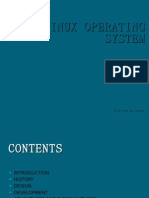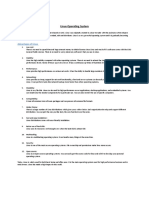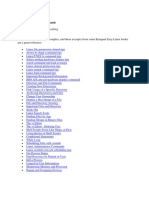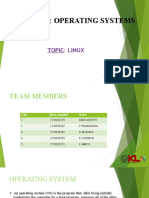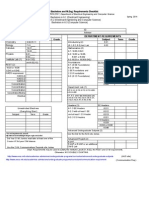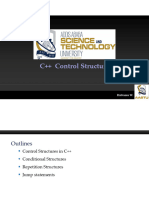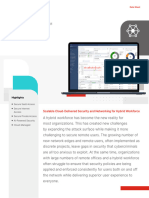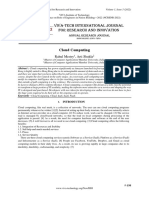0 ratings0% found this document useful (0 votes)
2 viewsFirstunit Linux
Linux is an open-source operating system that allows users to run and manage programs and hardware, making it popular among developers and companies. It features high customization, strong security, multitasking capabilities, and a supportive community. The document also covers the history of Linux, its various distributions, file systems, and the role of the Linux shell.
Uploaded by
suryavanshipriyanka2001Copyright
© © All Rights Reserved
Available Formats
Download as PPTX, PDF, TXT or read online on Scribd
0 ratings0% found this document useful (0 votes)
2 viewsFirstunit Linux
Linux is an open-source operating system that allows users to run and manage programs and hardware, making it popular among developers and companies. It features high customization, strong security, multitasking capabilities, and a supportive community. The document also covers the history of Linux, its various distributions, file systems, and the role of the Linux shell.
Uploaded by
suryavanshipriyanka2001Copyright
© © All Rights Reserved
Available Formats
Download as PPTX, PDF, TXT or read online on Scribd
You are on page 1/ 37
History Of Linux
Introduction of Linux Operating
System
Linux is an operating system—the
software that allows your computer or
device to run and manage programs
and hardware. It's like the "brain" of a
computer, helping it perform tasks like
running apps, connecting to the
internet, and managing files.
Unlikeother operating systems
(like Windows or macOS), Linux is
open-source, which means its code is
modify, and distribute. This has
made Linux very popular with
developers, tech enthusiasts, and
large companies.
Key Features of Linux:
Open-Source: The source code
(the set of instructions that make
up Linux) is available for anyone to
inspect, modify, and share. This
fosters collaboration and
innovation.
Free: Linux itself is free to
download and use. You don't have
to pay for a license, unlike Windows
Highly Customizable: You can
change almost anything in Linux.
Want a different look or a special
feature? You can modify the
operating system to suit your
needs, whether you're using it for
personal use, programming, or
running a server.
Security: Linux is known for being
very secure. It has built-in tools
that protect it from viruses and
other threats. Because it's open-
source, anyone can help identify
and fix security issues quickly.
Multitasking: Linux can run many
programs at once without slowing
down. It's great for both personal
use and running large, complex
systems like servers.
Strong Community Support: Since Linux
is open-source, there's a large and active
community of developers, enthusiasts, and
organizations who contribute to it. If you
have a problem or need help, you can
usually find an answer online.
Stabilityand Performance: Linux is
known for being stable, meaning it rarely
crashes. This makes it ideal for running
important applications and servers that
need to run without interruption.
Popular Versions of Linux:
Linux comes in many
different distributions (often
called distros), each designed for
different types of users and tasks.
Some popular ones include:
Ubuntu: A user-friendly version of
Linux, popular for personal
computers.
Fedora: A cutting-edge version,
History Of Linux
The history of Linux is a story of
how a small project grew into one
of the most important
technologies in the world.
The Beginning (1991): In 1991,
a Finnish student named Linus
Torvalds was frustrated with the
limitations of existing computer
operating systems. So, he decided
to create his own.
Linus made his work open-source,
meaning anyone could see the code,
use it, or even improve it. This was a
huge deal because most other
operating systems at the time were
closed and proprietary (meaning you
had to pay for them and couldn't
change them).
Early Growth: Linus released his
first version of Linux in 1991, and
people started using it and
contributing to its development.
Open Source Movement: At the
same time, there was a growing
movement in the software world that
advocated for sharing code and
collaborating to improve software.
This movement was championed
by Richard Stallman and his
creation of the Free Software
Foundation in the 1980s. They
pushed the idea of "free software,"
which meant software that was free
to use, modify, and share. Linux fit
Linux and the Community: As
Linux grew, a strong community of
developers, users, and companies
supported it. Major companies
like IBM, Google, and Red
Hat began using and contributing
to Linux, helping it become more
polished and powerful. This led to
Linux being used in a wide range
of applications, from personal
computers to servers,
smartphones (Android is based on
Linux Today: Today, Linux is
everywhere. It's used in many
types of devices—desktops,
laptops, servers, smartphones, and
even smart TVs. Many of the
world's largest websites, including
Google and Facebook, run on Linux
servers. The Linux Foundation,
created in 2000, continues to
support the development of Linux
and its community.
Shell
shellin the Linux operating system is a
program that allows users to interact
with the computer by typing
commands. It acts as a bridge between
the user and the operating system.
When you type commands into the
shell, it tells the computer what to do,
like running programs, managing files,
or setting system settings.
Different types of shells.
1. Bourne Shell (sh):
The Bourne Shell is one of the oldest
and most basic shells. It was created
by Stephen Bourne in the 1970s.
Itwas the standard shell on Unix systems
for a long time.
The Bourne Shell is simple and powerful,
allowing you to run commands, scripts,
and handle files easily.
While it's not as feature-rich as
some newer shells, it remains
important because many of its
features are still used in modern
shells like Bash.
Key features of Bourne Shell:
It provides a basic way to run
commands and automate tasks.
It uses simple scripts for managing
files and programs.
Korn Shell (ksh):
The Korn Shell was created by David
Korn in the 1980s. It's an
improvement over the Bourne Shell.
Itincludes all the features of the
Bourne Shell but adds more powerful
tools and shortcuts to make work
easier.
It'sfaster and more flexible than the
Bourne Shell and has features
like command history (so you can
recall previous commands) and job
Many Linux and Unix systems still use
the Korn Shell because it’s efficient
and powerful.
Key features of Korn Shell:
Ithas all the features of Bourne Shell
but with extra capabilities like
command history and job control.
Itsupports more complex scripts and
can handle large-scale tasks efficiently.
C Shell (csh):
The C Shell was created by Bill Joy in
the late 1970s and is based on the C
programming language.
Itis known for its user-friendly
features, like aliasing (giving
shortcuts to commands), job
control (managing background tasks),
and history (recalling previously used
commands).
The C Shell is great for people who are
familiar with C programming because
It’s
less popular today compared to
newer shells like Bash or Zsh, but still
useful in some environments.
Key features of C Shell:
It’sbased on the C programming
language, so it has a familiar syntax
for C programmers.
It includes useful features like aliasing
and job control, making it more user-
friendly.
Compare Linux file system
1)Structure
2)Directory Names
3)File Case Sensitivity
4)File Permissions:
1. Structure
Linux: The file system is organized like a tree
starting from the root ("/") directory. All files,
folders, and drives are inside this root.
Windows: Windows uses different drives
like C:, D:, etc. Each drive is like a separate
box.
2. Directory Names:
Linux: The directory names are simple and
use lowercase letters
(e.g., /home, /usr, /etc).
Windows: The directory names can be any
mix of uppercase and lowercase, and are
often more focused on drives (e.g., C:\
3. File Case Sensitivity:
Linux:It’s case-sensitive,
meaning file.txt and File.txt are different
files.
Windows: It’s case-insensitive,
meaning file.txt and File.txt are the same.
Windows: External devices appear as
separate drives (like E:, F:) and you access
them directly
4. File Permissions:
Linux: Files have strict permissions
for owner, group, and others (can read,
write, or execute).
Windows: Files also have permissions, but
they are managed through a different
system based on user accounts.
Linux releases
1. Ubuntu:
Purpose: Beginner-friendly, general-purpose
desktop use.
Key Features: Easy to use, good for new
Linux users, regular updates, strong
community support.
Popular Versions: Ubuntu Desktop, Ubuntu
Server.
ReleaseCycle: Every 6 months (with Long-
Term Support (LTS) releases every 2 years).
Example: Ubuntu 20.04 (LTS), Ubuntu 22.04
2. Fedora:
Purpose: Cutting-edge features and
technologies, often used by developers
and enthusiasts.
KeyFeatures: Latest software and
updates, backed by Red Hat.
Popular Versions: Fedora Workstation
(for desktops), Fedora Server.
Release Cycle: Every 6 months.
Example: Fedora 34, Fedora 35.
3. Debian:
Purpose: Known for stability and
reliability, often used for servers.
Key Features: Stable and robust, but
can be a bit slow with the latest
software.
Popular Versions: Debian stable,
Debian testing.
Release Cycle: Debian releases don’t
follow a strict schedule but happen
roughly every 2-3 years.
Linux File Systems and versions
A file system is how an operating system
organizes and stores files on a storage
device (like a hard drive). In Linux, there
are different types of file systems, each
designed for specific needs. Here are some
common ones:
EXT4 (Fourth Extended File System):
What it is: The most popular and default
file system for Linux.
Why it’s used: It's fast, stable, and
works well for most users.
Btrfs : (B-tree File System):
A newer, more advanced file system.
used: It supports features like snapshots
(backups of your system) and better data
protection.
Used for: Servers and advanced users
who need more flexibility.
XFS:
A high-performance file system.
used: It's good at handling large files and
is often used in servers.
Used for: High-performance or large data
F2FS (Flash-Friendly File System):
Designed for devices that use flash
memory, like SSDs (Solid State Drives).
used: It’s optimized for speed on flash
storage devices.
Used for: SSDs and flash-based storage.
NTFS:
The default file system used by Windows.
used: Linux can read and write to NTFS,
which is useful for dual-boot systems or
accessing Windows files.
Linux Versions :A Linux
version or distro is a specific release or
distribution of the Linux operating system.
Each version is a mix of the Linux kernel
(the core) and other software. Here are
some popular Linux versions:
Ubuntu:
What it is: One of the most popular
Linux distros.
Why it’s used: It’s easy to use, with
lots of support and a large community.
Best for: Beginners or general desktop
Fedora:
What it is: A cutting-edge Linux distro
with the latest features.
Why it’s used: It’s always up-to-date
with the newest software.
Best for: Developers and people who
want the latest technologies.
Example: Fedora 35.
Thank you
Assignment
1. Describe the history of linux in deatail?
2. What do you mean by Linux? Explain its features.
3. Explain the role of the Linux shell. How does it interact with the
kernel to execute commands?
4. What is shell? Write the different type of shell in linux?
5. What are the different file system in linux?
6. Explain the term in the following
a) Ubuntu b)Fedora c)Debian
You might also like
- System Design - Sequencer - Grokking Modern System Design Interview For Engineers & Managers33% (6)System Design - Sequencer - Grokking Modern System Design Interview For Engineers & Managers1 page
- Remote Controller Visionline 3G/4G Rfid: Installation ManualNo ratings yetRemote Controller Visionline 3G/4G Rfid: Installation Manual39 pages
- Software Requirements Specification Music Recommendation System PDFNo ratings yetSoftware Requirements Specification Music Recommendation System PDF14 pages
- Linux and Windows Operating system FundamentalsNo ratings yetLinux and Windows Operating system Fundamentals60 pages
- Chapter Five Network Items SpecificationNo ratings yetChapter Five Network Items Specification37 pages
- Module 1 Linux History and Commands by Shakti SinghNo ratings yetModule 1 Linux History and Commands by Shakti Singh6 pages
- Unit 2 Operating System and Its ServicesNo ratings yetUnit 2 Operating System and Its Services11 pages
- Unit-1 - Overview of Linux: What Is Linux, Linux S Root in Unix, Common Linux Features, Advantage ofNo ratings yetUnit-1 - Overview of Linux: What Is Linux, Linux S Root in Unix, Common Linux Features, Advantage of13 pages
- FROM Http://markun - Cs.shinshu-U.ac - Jp/learn/linux/e - H - 01-01.htmlNo ratings yetFROM Http://markun - Cs.shinshu-U.ac - Jp/learn/linux/e - H - 01-01.html3 pages
- Linux: A Comprehensive Guide to Linux Operating System and Command LineFrom EverandLinux: A Comprehensive Guide to Linux Operating System and Command LineNo ratings yet
- 6 - T4 -OS Security - Introduction of LinuxNo ratings yet6 - T4 -OS Security - Introduction of Linux21 pages
- Subject: Operating Systems: Topic: LinuxNo ratings yetSubject: Operating Systems: Topic: Linux26 pages
- Linux Operating System PPT by Quontra SolutionsNo ratings yetLinux Operating System PPT by Quontra Solutions35 pages
- Ques1. Explain UNIX System Architecture.: Ans. at The Center of The UNIX Onion Is ProgramNo ratings yetQues1. Explain UNIX System Architecture.: Ans. at The Center of The UNIX Onion Is Program9 pages
- Mat2004 Operation-Research LT 1.0 1 Mat2004No ratings yetMat2004 Operation-Research LT 1.0 1 Mat20042 pages
- Dell Emc Openmanage Ansible Modules: Version 1.0.1 User'S GuideNo ratings yetDell Emc Openmanage Ansible Modules: Version 1.0.1 User'S Guide41 pages
- (MMU) Software Varification and Validation - Lecture 2No ratings yet(MMU) Software Varification and Validation - Lecture 218 pages
- LogSed Anomaly Diagnosis Through Mining Time-Weighted Control Flow Graph in LogsNo ratings yetLogSed Anomaly Diagnosis Through Mining Time-Weighted Control Flow Graph in Logs9 pages
- csr8670-audio-flash-product-brief_87-ce851-1-b(1)No ratings yetcsr8670-audio-flash-product-brief_87-ce851-1-b(1)2 pages
- Cloud Computing: Rahul Mestry, Arti ShuklaNo ratings yetCloud Computing: Rahul Mestry, Arti Shukla6 pages
- Essential Python Data Visualization Libraries 1687141550No ratings yetEssential Python Data Visualization Libraries 168714155016 pages
- System Design - Sequencer - Grokking Modern System Design Interview For Engineers & ManagersSystem Design - Sequencer - Grokking Modern System Design Interview For Engineers & Managers
- Remote Controller Visionline 3G/4G Rfid: Installation ManualRemote Controller Visionline 3G/4G Rfid: Installation Manual
- Software Requirements Specification Music Recommendation System PDFSoftware Requirements Specification Music Recommendation System PDF
- Module 1 Linux History and Commands by Shakti SinghModule 1 Linux History and Commands by Shakti Singh
- Unit-1 - Overview of Linux: What Is Linux, Linux S Root in Unix, Common Linux Features, Advantage ofUnit-1 - Overview of Linux: What Is Linux, Linux S Root in Unix, Common Linux Features, Advantage of
- FROM Http://markun - Cs.shinshu-U.ac - Jp/learn/linux/e - H - 01-01.htmlFROM Http://markun - Cs.shinshu-U.ac - Jp/learn/linux/e - H - 01-01.html
- Linux: A Comprehensive Guide to Linux Operating System and Command LineFrom EverandLinux: A Comprehensive Guide to Linux Operating System and Command Line
- Ques1. Explain UNIX System Architecture.: Ans. at The Center of The UNIX Onion Is ProgramQues1. Explain UNIX System Architecture.: Ans. at The Center of The UNIX Onion Is Program
- Dell Emc Openmanage Ansible Modules: Version 1.0.1 User'S GuideDell Emc Openmanage Ansible Modules: Version 1.0.1 User'S Guide
- (MMU) Software Varification and Validation - Lecture 2(MMU) Software Varification and Validation - Lecture 2
- LogSed Anomaly Diagnosis Through Mining Time-Weighted Control Flow Graph in LogsLogSed Anomaly Diagnosis Through Mining Time-Weighted Control Flow Graph in Logs
- Essential Python Data Visualization Libraries 1687141550Essential Python Data Visualization Libraries 1687141550







